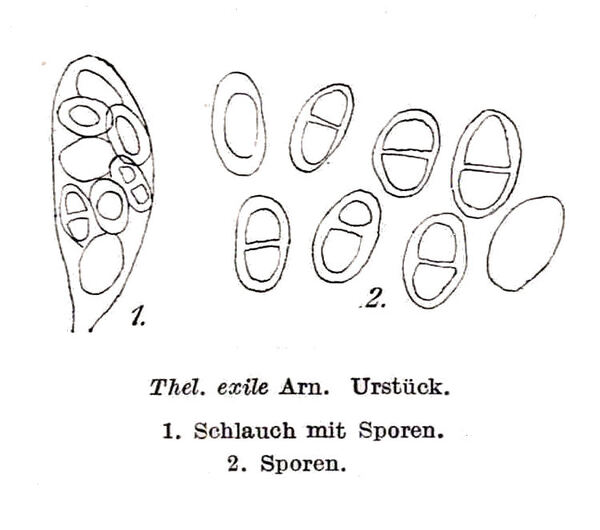Thelidium exile Arnold
Flora, 65, 26: 410, 1882.
Synonyms:
Distribution: N - TAA (Nascimbene & al. 2022).
Description: Thallus crustose, endosubstratic, dirty white to pale grey, often poorly visible. Perithecia black, numerous, 0.1-0.25 mm across, largely immersed in pits in the rock, emerging only with the somewhat pointed apex. Involucrellum absent; exciple dark throughout; hamathecium of periphyses and periphysoids, interascal filaments absent; hymenial gel I+ red (I+ blue at very low concentrations of I), K/I+ blue. Asci 8-spored, ellipsoid to clavate, c. 60 x 20 μm, I-, fissitunicate, the wall thickened above, with an ocular chamber, dehiscent by extrusion of a delicate rostrum. Ascospores 1-septate, hyaline, broadly ellipsoid, 13-18 x 8-9 μm, rounded at both ends. Photobiont chlorococcoid. Spot tests: K-, C-, KC-, P-, UV-. Chemistry: without lichen substances.Note: on more or less calciferous rocks in upland areas. The species was frequently considered as a synonym of T. minutulum, but according to Roux & coll. (2014) it differs in having half-projecting perithecia.
Growth form: Crustose
Substrata: rocks
Photobiont: green algae other than Trentepohlia
Reproductive strategy: mainly sexual
Commonnes-rarity: (info)
Alpine belt: extremely rare
Subalpine belt: very rare
Oromediterranean belt: absent
Montane belt: very rare
Submediterranean belt: absent
Padanian area: absent
Humid submediterranean belt: absent
Humid mediterranean belt: absent
Dry mediterranean belt: absent

Predictive model
Growth form: Crustose
Substrata: rocks
Photobiont: green algae other than Trentepohlia
Reproductive strategy: mainly sexual
Commonnes-rarity: (info)
Alpine belt: extremely rare
Subalpine belt: very rare
Oromediterranean belt: absent
Montane belt: very rare
Submediterranean belt: absent
Padanian area: absent
Humid submediterranean belt: absent
Humid mediterranean belt: absent
Dry mediterranean belt: absent

Predictive model
 INDEX FUNGORUM
INDEX FUNGORUM
 GBIF
GBIF
 DOLICHENS
DOLICHENS


